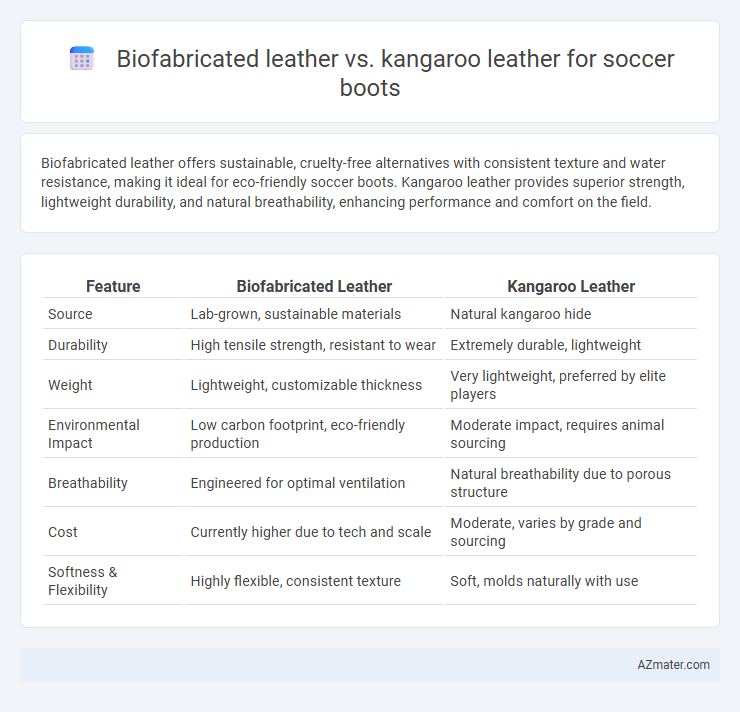Biofabricated leather offers sustainable, cruelty-free alternatives with consistent texture and water resistance, making it ideal for eco-friendly soccer boots. Kangaroo leather provides superior strength, lightweight durability, and natural breathability, enhancing performance and comfort on the field.
Table of Comparison
| Feature | Biofabricated Leather | Kangaroo Leather |
|---|---|---|
| Source | Lab-grown, sustainable materials | Natural kangaroo hide |
| Durability | High tensile strength, resistant to wear | Extremely durable, lightweight |
| Weight | Lightweight, customizable thickness | Very lightweight, preferred by elite players |
| Environmental Impact | Low carbon footprint, eco-friendly production | Moderate impact, requires animal sourcing |
| Breathability | Engineered for optimal ventilation | Natural breathability due to porous structure |
| Cost | Currently higher due to tech and scale | Moderate, varies by grade and sourcing |
| Softness & Flexibility | Highly flexible, consistent texture | Soft, molds naturally with use |
Introduction to Soccer Boot Materials
Biofabricated leather offers a sustainable alternative to traditional materials, using cultured collagen to replicate the durability and flexibility required for soccer boots. Kangaroo leather is prized for its exceptional strength-to-weight ratio, providing superior touch and agility on the field. Comparing these materials highlights innovations in soccer boot manufacturing aimed at enhancing performance while addressing environmental impact.
What is Biofabricated Leather?
Biofabricated leather is an innovative, sustainable material created through cellular agriculture, where animal cells are cultured to produce leather without harming animals. This type of leather offers high durability and flexibility, making it suitable for soccer boots that require strength and comfort. Compared to traditional kangaroo leather, biofabricated leather reduces environmental impact by minimizing land use, water consumption, and greenhouse gas emissions during production.
The Origins of Kangaroo Leather
Kangaroo leather, sourced primarily from Australia, is prized for its exceptional strength-to-weight ratio and natural flexibility, making it a preferred material in premium soccer boots. This leather is derived from the hides of wild kangaroos, sustainably managed under strict wildlife regulations to ensure minimal environmental impact. Compared to biofabricated leather, kangaroo leather offers superior durability and breathability due to its dense fiber structure, although biofabricated alternatives provide innovative solutions with reduced ecological footprints.
Material Performance: Flexibility and Comfort
Biofabricated leather offers enhanced flexibility due to its engineered fiber structure, allowing soccer boots to conform more naturally to foot movements, improving overall comfort. Kangaroo leather is renowned for its lightweight, supple texture and high tensile strength, delivering excellent comfort and durability in soccer boots. While kangaroo leather excels in natural breathability, biofabricated leather can be tailored to optimize moisture-wicking properties, reducing discomfort and enhancing performance on the field.
Durability and Longevity Compared
Biofabricated leather demonstrates superior resistance to environmental wear and tear, maintaining structural integrity over extended use compared to kangaroo leather. Kangaroo leather, while prized for its lightweight flexibility and natural breathability, tends to show signs of abrasion and stretching after prolonged exposure to intense activity. The engineered consistency of biofabricated leather translates into enhanced durability and longer lifespan in high-performance soccer boots.
Environmental Impact and Sustainability
Biofabricated leather for soccer boots significantly reduces environmental impact by minimizing water consumption, greenhouse gas emissions, and deforestation associated with traditional kangaroo leather production. Kangaroo leather, while strong and durable, involves ethical concerns and contributes to biodiversity loss due to hunting practices, impacting ecosystems. The sustainable manufacturing process of biofabricated leather offers a renewable alternative that supports circular economy principles and reduces reliance on animal agriculture.
Ethical Considerations in Leather Sourcing
Biofabricated leather offers a sustainable and cruelty-free alternative to traditional kangaroo leather, significantly reducing animal welfare concerns associated with soccer boot production. Kangaroo leather sourcing raises ethical issues due to potential overhunting and habitat disruption, sparking debates on wildlife conservation. Utilizing biofabricated leather supports environmentally responsible practices, aligning with growing consumer demand for ethically sourced sportswear materials.
Water Resistance and Weather Performance
Biofabricated leather offers superior water resistance compared to kangaroo leather, thanks to its synthetic composition designed to repel moisture effectively. Kangaroo leather, while naturally breathable and lightweight, tends to absorb water, which can affect its durability and performance in wet conditions. Soccer boots made with biofabricated leather maintain consistent weather performance, providing enhanced protection against rain and humidity, critical for maintaining grip and comfort during play.
Player Experience and Field Performance
Biofabricated leather offers a lightweight, breathable alternative to kangaroo leather, enhancing player comfort and reducing foot fatigue during extended play. Kangaroo leather remains favored for its natural elasticity and superior touch, providing exceptional ball control and durability on diverse field conditions. Players may notice improved agility and responsiveness with biofabricated options, while traditional kangaroo leather boots excel in delivering a consistent, high-performance feel.
Future Trends in Soccer Boot Material Innovation
Biofabricated leather is emerging as a sustainable alternative to kangaroo leather in soccer boot manufacturing, offering comparable durability and flexibility with a significantly lower environmental impact. Innovations in biofabrication techniques harness microbial cellulose and plant-based proteins to produce lightweight, water-resistant materials that enhance performance and reduce carbon footprints. The shift towards biofabricated leather aligns with the growing demand for eco-conscious sportswear, signaling a transformative trend in soccer boot material innovation focused on sustainability and high-performance functionality.

Infographic: Biofabricated leather vs Kangaroo leather for Soccer boot
 azmater.com
azmater.com